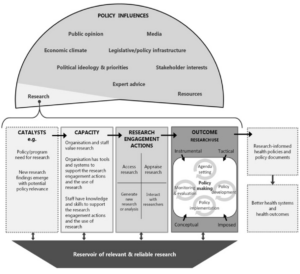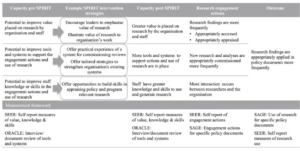Purpose: to provide insight into the process through which research findings can have an impact on policy
Who is it for: research managers, policy makers, researchers
Technique: analysis of process
Type of tool: implementation tool
Prior knowledge: intermediate
Complexity: average
Time investment: days
Downloads
Links
Related tools
What is the SPIRIT Action Framework?
Governments are increasingly recognizing the informative value of research findings during policymaking and implementation of policy. Although this can be an important channel for the impact of research, it does not happen automatically. Governments are therefore trying to promote the use of research findings in their organizations through various strategies.
However, the use of research findings for policymaking and implementation is a complicated process involving diverse actors, motivations, and dynamics. The SPIRIT Action framework provides insight into how research findings inform policymaking and implementation through an overarching framework. This framework derives its name from the evaluation and intervention study in which it was developed (‘Supporting Policy In health with Research: An Intervention Trial’).
The SPIRIT Action framework shown in the image below breaks down into two parts. The top half of the figure provides an overview of the different policy influences. This part of the figure thus positions the policy influence of research findings in the broader context and reminds the user that there are many more influences that influence policy directly or through interactions with each other. To gain insight into the interactions between these actors and influences, one can look at the Flows of Knowledge framework.

The bottom half of the figure forms the practical core of the SPIRIT Action framework and focuses on how research findings can realize policy influence. It distinguishes four successive steps:
- Catalysts: The primary task of policymakers is to develop and implement government policy, rather than to consider research findings for its own sake. The framework assumes that there is a catalyst that triggers a policymaker’s use of research findings. For example, a need for information to answer a specific problem in the design of policies or programs, or to help support a case for funding or public persuasion. The catalyst could also be compelling new research findings suggesting a different or modified policy agenda.
- Capacity: the internal capacities of the government organisation then determine the extent to which the catalyst also ensures that research findings are actually acted upon. Capacity includes: (1) the value placed on research by the organisation and staff, (2) the tools and systems available to the organisation to support research engagement and (3) the skills and knowledge of the staff.
- Interactions with research findings: If a government organization has sufficient capacity, its staff will be more likely to interact with research. It distinguishes four levels, i.e. (1) accessing research, (2) appraising research, (3) generating new research or (4) interacting with researchers. These four ‘engagement actions’ bridge the gap between the potential reflected in the capacity to use research and its final application.
- Research use: interacting with research and the actual application to policy are not the same. However, the stronger the interaction with the research findings, the greater the chance that the application will take place. Four different ways are distinguished: (1) conceptual for ideation, (2) instrumental for designing policy interventions, (3) tactical to justify choices already made, (4) imposed to comply with internal guidelines. This can take place in four phases of policy development: (1) to support agenda setting, (2) policy development, (3) policy implementation or (4) monitoring and evaluation.
How do you use the SPIRIT Action Framework?
The SPIRIT Action framework provides a process-based insight into how research findings find their way into policymaking and the implementation of policy. No direct working method is described, but the SPIRIT Action framework can be used as a starting point for looking at barriers in how research findings find their way into policy. By mapping out the barriers, strategies can be chosen to overcome these barriers.
The following structure can be used for this. The first step is to identify where the bottleneck is based on the SPIRIT Action framework. If, for example, it turns out that ‘the organisation and staff see little value in the use of research findings’, targeted activities can be set up to address this. For example, by encouraging leaders within the organization to better communicate the importance of using research findings. If this gives a more important value to the use of research findings in the organization, this can contribute to a better use of research findings by the organization.

What is the origin of the SPIRIT Action Framework?
The SPIRIT Action framework was developed in Australia between 2011 and 2013 as part of an intervention and evaluation study called SPIRIT (Supporting Policy In health with Research: An Intervention Trial) and first described in 2015 by Sally Redman et al. in the journal Social Science & Medicine.
An extensive literature review on the factors that play a role in the use of research findings in policy was the starting point for the development of the framework. Subsequently, through interviews and further literature study, the Action framework was built iteratively, looking closely at whether the framework met the requirements that a usable Action framework must meet.





